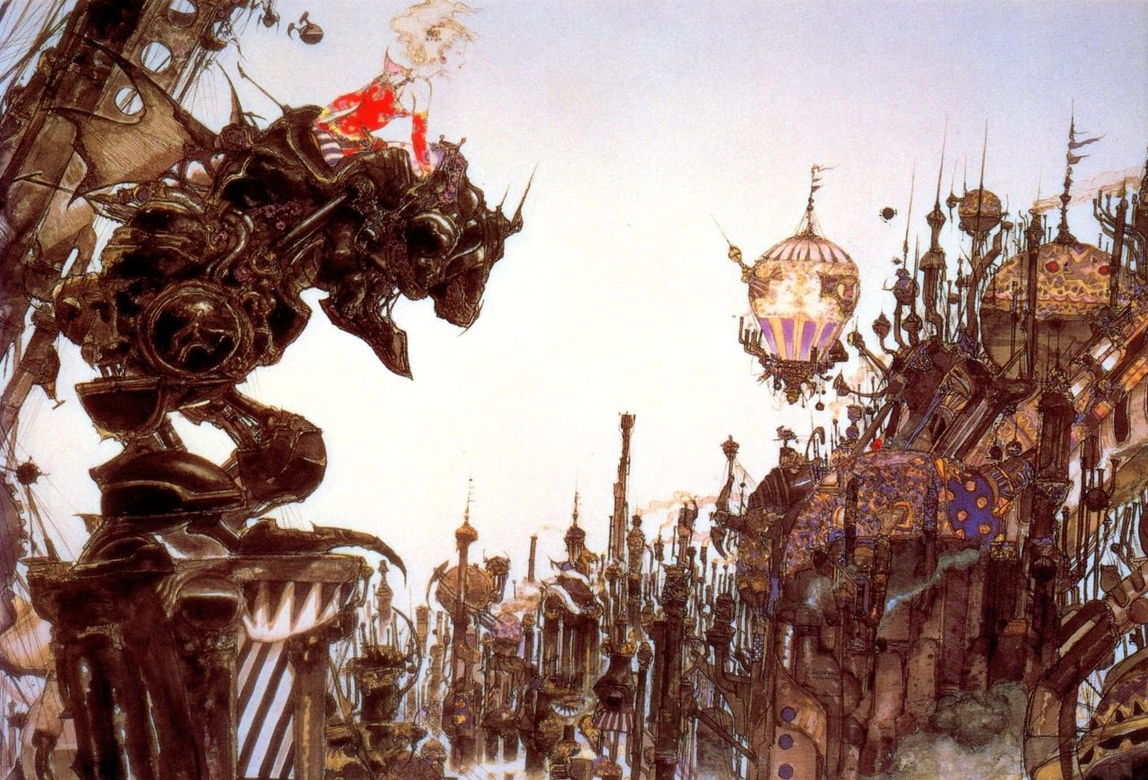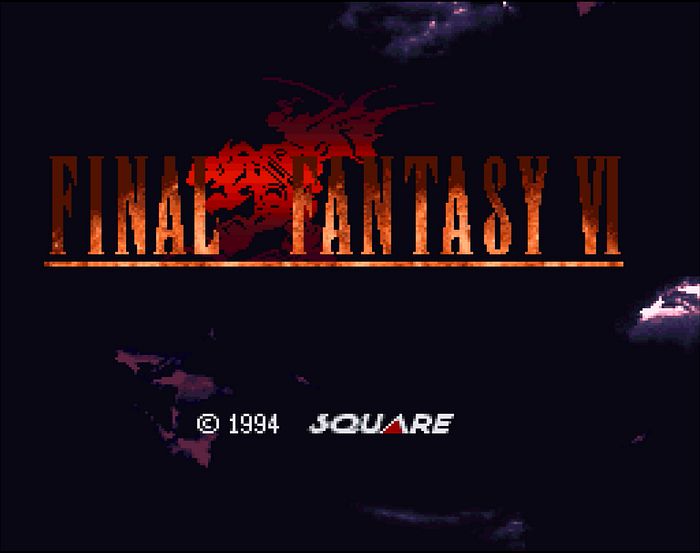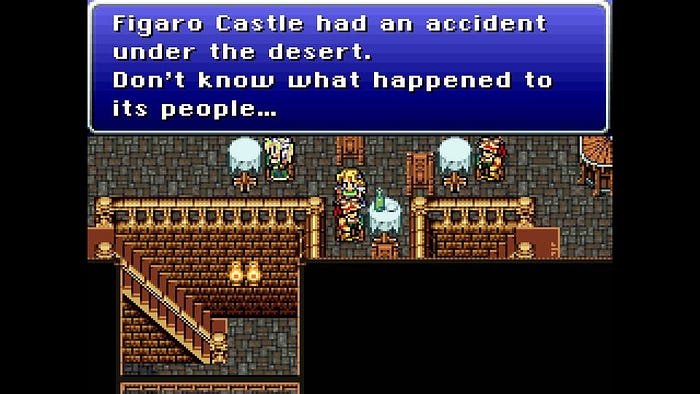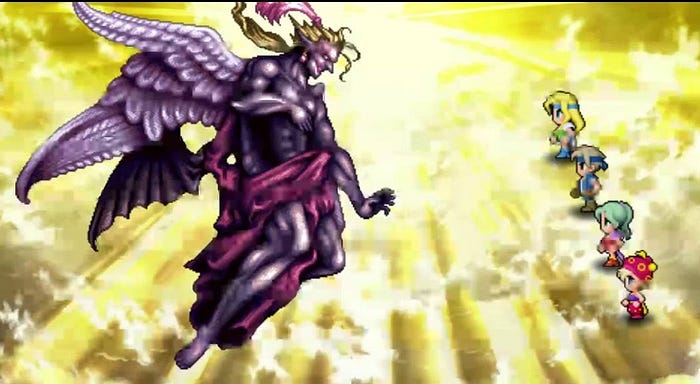Final Fantasy VI is the Most Important Final Fantasy
Why this 1994 classic remains a fixture of the series

Purple lightning flashes, occluded by foreboding clouds the color of ink. A somber melody plays, operatic and minor, each note resounding from the press on an organ key. As if presenting a horror masterpiece — and not an RPG — the title, Final Fantasy VI, rises in lettering of rust and burned paper, the score reaching a harrowing and haunting apex, a chilling exclamation of Phantom of the Opera-level audial gore.
1994. Squaresoft.

As we are removed from the title screen and taken from what must be the harbinger of our collective doom, the setting changes dramatically. The clouds and lightning vanish. We are drawn downward, into darkness. The soundtrack is no longer operatic and terrifying but signals the start of an adventure, notes tinkling and dwindling as our gaze sweeps across the crags and lights of a distant city, built from a mountainous cleft of stone.
An exposition is brought to us, a piece of narration that is small in detail but sweeping in scope. The War of the Magi. The lost power of magic. Steam power. Machines. The breadth of a thousand years. As we are granted the bird’s perspective of this small, frozen town, we see the bustle of smallfolk in their daily activities, of chimneys in their smoky tell of a hearth fire, of rooftops encrusted with snow and iron engines burning coal. We cut, again, to iron and steel, to the magnificent ziggurat of imperial standard, and back again to our lonely and abandoned plateau of ice and stone.
Mankind, we are told, is about to repeat an abhorrent mistake.
A cold wind howls and three figures reach the plateau, the metal hooves of their magitek armors shuffling through tundra and untouched snowbank. Two of them — military men, company men — ruminate over their orders, and over the psychotic killer they’ve been tasked to babysit. An automaton, a woman, a powerful cryptid of unnatural gift has been assigned to their study of the town. She’s a murderer, a monster, in ways no different from the very Esper they’ve come to claim.
As the trio of magitek armors make their final approach toward the cold town of Narshe, a somber theme plays over the snowfall. We see names. Yoshinori Kitase. Hiroyuki Itou. Ken Narita. Tetsuya Nomura. Nobuo Uematsu. Yoshitaka Amano.

A Collaboration of Genius
Final Fantasy VI would be the first Final Fantasy game not directed by Hironobu Sakaguchi. The first Final Fantasy game with split directors, Kitase for event and scenario, Ito for the battles. Under Sakaguchi’s supervision, this would be Kitase’s first big foray and cement him as a formidable director.
Final Fantasy VI eschewed the protagonists of previous games to instead attempt at making everyone — and no one — the protagonist. Ideas for characters were split between designers: Terra and Locke by Sakaguchi; Celes and Gau by Kitase; Shadow and Setzer by Nomura; Edgar and Sabin by Kaori Tanaka. Tetsuya Takahashi, who would go on to create Xenogears, Xenosaga, and Xenoblade, worked on the game’s graphics and was responsible for the unique design of the magitek armors.
There’s no central main character in FF6 — all 12 of them are equally the “main character” so starting with Celes [it] just made sense in the overall flow of the story. We were concerned that if we started it with Terra, it would place too much relative importance on her story. Also, we wanted to give Terra some extra backstory, and show what she had been up to since the world had been destroyed. (Staff interview, V-Jump 1994)
Final Fantasy VI was a group effort, an anthology, both a celebration of what had come before and a complete reworking of what the name Final Fantasy would come to mean.
Final Fantasy, up until Final Fantasy VI in 1994, had a mostly loose definition of theme, tone, and makeup. While mainstays were already apparent — such as reusing item, spell, and creature names — there was little defining the series apart from its fantasy world settings. Up through the fifth entry in the series, Final Fantasy had retained its high fantasy flair of dragons, elves, and goblins against bright backdrops in locales influenced by western fantasy tropes.
Final Fantasy VI would be a wrench, a pull to the other side, a dark game about industry that took the series’ ideas of rebellion and empire into the stratosphere. While maintaining a serious tone throughout much of the game, Final Fantasy VI included enough of the levity established in previous entries that it would not become laden by its themes. While Final Fantasy IV had been tonally darker than its brethren, Final Fantasy V reintroduced an overly goofy narrative that was reinforced by its swashbuckling, extradimensional plot.
Final Fantasy VI would serve as the new anchor of the series, the focal point upon which much of the next few generations would come to define themselves.

The Backbone of Final Fantasy
For many and most, the journey of Final Fantasy began and ended with the seventh installment. Still a titanic fixture in the gaming consciousness, Final Fantasy VII established itself with three-dimensional graphics, a Hollywood scope, memorable characters, and brutal themes. Final Fantasy VII paved the way for Final Fantasy’s modernity, still touted by many as the greatest RPG of all time. Despite the fact that previous English localizations had messed up the numbering conventions of the series from their Japanese counterparts, Final Fantasy VII entered the western consciousness with no explanation of its numbering or placement. It was the game that it was, fondly played and fondly remembered.
Everyone’s journey through Final Fantasy is different. As the years wear on, we are met with resistance to play older entries in the series, whether due to graphical resentment or accessibility issues. Final Fantasy VII, fully embraced by Square as the pinnacle of the series, has enjoyed decades of official fanservice that has helped reinforce its mainstream public image. There have been many different celebrations and misfires in the series across the years — most of the entries post-Final Fantasy XII have met equally mixed and rave successes.
Final Fantasy would simply not be what it is today without the existence of Final Fantasy VI, and despite the gulf in years between releases, it has been unfortunately overshadowed by Final Fantasy VII in too many ways. Still, if you are looking for the fusion of fantasy and science-fiction, the exploration of deeper themes, memorable and unique characters, and a world memorable on sight, Final Fantasy VI is where so much of what we know reached its stride. From the standpoint of developers and artisans, Final Fantasy VI remains a pool of knowledge, a vast and perfect well where the series can continue reaching for the future by repeatedly entreating with its past.
Final Fantasy, as a series, continues to draw from itself for reference and inspiration. The games, while not enjoying numerical order under any illusion of connective tissue, build upon their forebears by crafting new and interesting worlds that aim to feel like Final Fantasy by relying on tropes, characters, spells, locations, and more that we can immediately recognize. Final Fantasy XV, the most recent entry in the series, not only borrowed from Final Fantasy VI in feel and scope but in design reference such as its World of Ruin. Final Fantasy XIV, now incredibly successful, has its bones in Final Fantasy VI. Everything from magitek armor to the Garlean Empire’s similarities with Gestahl, to including the Phantom Train, Doma, Ultros, and Typhon — even Kefka makes an appearance.
The reach of Final Fantasy VI can be felt in this celebration of modernity, in the strongest Final Fantasy tropes, all distilled from how well they were presented in that game from 1994.

More Than A Classic
After more than 25 years, Final Fantasy VI is more than just a “classic.” It’s the reason that Final Fantasy has become the titan it is, coherently fusing together all of the series’ most defining aspects for the first time in a way that felt as though it were pushing not only the series but the entire medium, forward.
Final Fantasy VI, instead of retaining the job classes established in Final Fantasy III and V, baked its classes into each of its highly unique characters. While four of them were technically optional, from a gaming perspective none of them should go overlooked. This eclectic perspective allowed the player not only to utilize the characters for their differing skills (Celes could absorb magic, and Sabin could use unique button input attacks) but to craft a part where their favorites were established by flavor.
Where Final Fantasy IV also had characters who were attached to jobs (Kain was a Dragoon and Cecil a Paladin), Final Fantasy VI included a secondary customizable element in its Espers. Once Espers were unlocked, equipping them would, over time, create stat changes in the equipped character as well as allow them to permanently learn unique magical spells (a component refined in Final Fantasy VII under the materia system). Even the limit break as we know it made its debut in this game.
Tetsuya Takahashi: This time, each of the characters has a distinct ability, similar to the job system, and you can think of their fixed abilities as job commands. I think the battles actually have more strategy than FFV. (1994 Game-On Interview)
Final Fantasy VI is remembered for its distinguishing features. Beyond the “Mode A7” airship flight (a feature on the SNES that allowed airship travel to look like it was happening in a pseudo-third dimension) or its uniquely detailed sprites, Final Fantasy VI is a game remarkably split into two halves. The first half of the game is surprisingly linear, pushed by the fervent pace of the game’s story. In the second half, we are treated to the unique outcome of failure; Kefka has succeeded and the world has fallen to ruin. The second half of the game becomes largely optional, with the world torn apart and your party scattered to its four corners.
While you learn almost immediately where Kefka is, it is up to the player to decide how many optional party members, spells, Espers, and weapons they wish to find before making the final approach. This is a feature that we would see emulated in later entries; Final Fantasy XIII is almost perfectly split in half between the story in the first half and optional content in the second. Final Fantasy XV traverses its open-world with a flair of optional content, emptied of story.
This unique blend of linear storytelling with freeform adventure turns Final Fantasy VI into a rather beloved element in terms of its design, where the lack of a determined protagonist allows the player to engage with the characters they find most appealing, and rebuild the world with the ones they love.

Beyond a World of Ruin
Final Fantasy VI is absolutely packed with memorable moments. The river sequence. The opera house. The World of Ruin. Memorable moments that would not only live in the minds of players for years but would become pinnacles of momentous design in the medium. Final Fantasy VI is so fondly remembered because it gives itself wholeheartedly to each of its moments, crafting not a singular fantasy adventure but a series of impactful events threaded together by a host of well-written characters.
This is a role-playing game, but in its laurels rest the beginnings of majesty, the building blocks of a herculean future where storytelling would be paced by impeccable character design. It’s no surprise that after Final Fantasy VI, much of the team would be absorbed by the needs of Chrono Trigger, and its biggest players would go on to use everything they’d learned in the creation of Final Fantasy VI to make Final Fantasy VII.
In tone, Final Fantasy VI established itself by not shying away from the biggest parts of being human. While aspects of the human condition had been represented in the previous five entries, Final Fantasy VI included subjects such as familial abuse, genocide, suicide, industrial warfare, colonialism, perpetual warfare, and violent narcissism in stretches much more advanced than what had been explored before.
Some of the most memorable moments in Final Fantasy VI are the ones most difficult to swallow, such as Terra taking care of the children in the orphanage or Celes attempting to kill herself. The second half of Final Fantasy VI — the World of Ruin — takes many of the game’s themes to satisfying conclusions that are incredibly relevant in today’s tumultuous times.
Yoshinori Kitase: “We originally planned for the party to save the world and defeat Kefka just as things were looking grim and the world was about to be destroyed. Then we started talking about reworking that.” (Via The Gamer)
The post-fantasy world gifted to us in Final Fantasy VI feels like the blueprint for what Final Fantasy is now. If you have not played this game in some time, I urge you to go back and experience it. Take in all its charms and woes, and see for yourself why it is truly the bones of what makes Final Fantasy great, a fusion of science fiction and fantasy elements lovingly crafted with an important story and endearing characters. Final Fantasy VI not only established what it meant to be a Final Fantasy — what it meant to be an RPG — but fully diversified our expectations over what could be possible in this kind of setting, this kind of game.

In the same way that Studio Ghibli’s Castle in the Sky ignited imaginations that resulted in endless creative works, Final Fantasy VI continues to inspire both within the series, and without. Whether it's because of its memorable monster design, impressive musical score, or deeply nostalgic world, Final Fantasy VI remains the culmination of everything that makes the series great.
We continue to engage in discussions about what makes a Final Fantasy game feel like, well, Final Fantasy. Whether or not the series has regained its footing or lost its way, there’s little argument that Final Fantasy VI not only retains the spirit of the series but exemplifies it.
Hironobu Sakaguchi: “It might sound like I’m patting myself on the back, but for an older game, Final Fantasy VI is honestly still a very fun game today. From here video games entered a world of 3D, and the scale of video games kept growing, but I felt that this in its own way is still a game that can be enjoyed today.” (Famitsu, via Siliconera)
